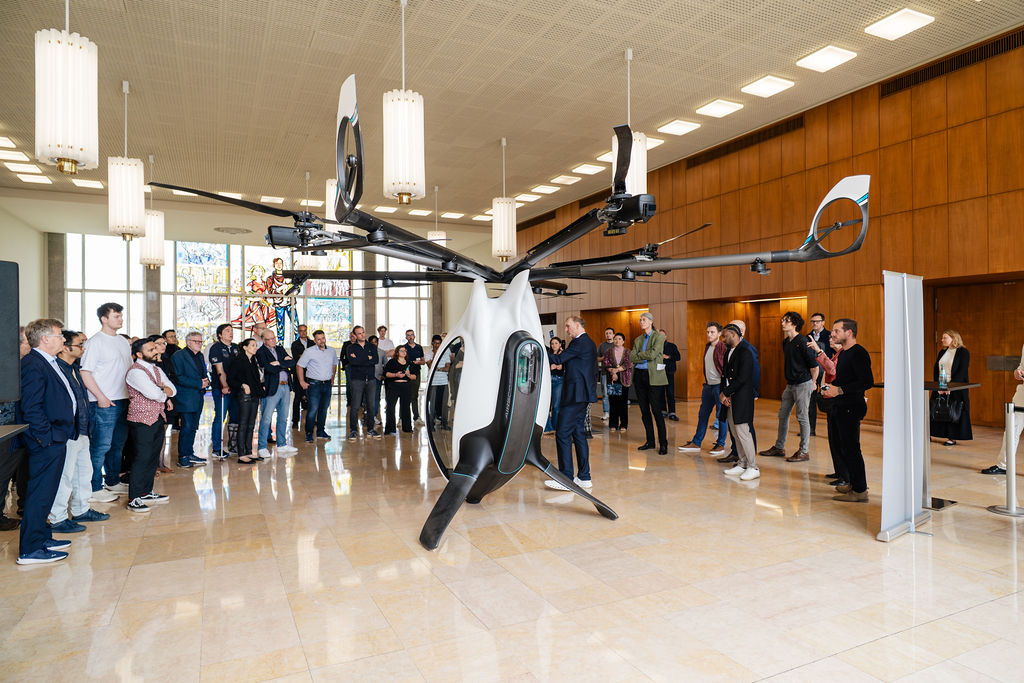Flying into the future with deep-tech mobility

On a summer evening in Berlin, visitors to the ESMT campus didn’t just talk about the future – they came face to face with it. During a live prototype showcase in the foyer of the ESMT campus at Schlossplatz 1, almost 100 guests gathered to experience what might be the next chapter in personal mobility. The June 10 event, “Flying into the Future,” was hosted by DEEP – Institute for Deep Tech Innovation at ESMT – in collaboration with Zapata and Team Global. Its goal: to explore the promise and the pragmatism of advanced air mobility (AAM).
At the heart of the event was the AirScooter, a lightweight, single-passenger flying machine developed by inventor and entrepreneur Franky Zapata. Designed for intuitive control and recreational use, the AirScooter showcases how aviation technology is evolving beyond airports and airliners. But the evening’s focus extended beyond one vehicle and spotlighted a broader ecosystem of disruption, blending aerospace engineering, venture capital, sustainable fuels and materials, and public policy.
A skyward shift in mobility
Opening the event, DEEP Managing Director Thorsten Lambertus reminded the audience of the limits of today’s infrastructure. “Could we add more streets to Manhattan? More tracks to the German rail network? More runways to Heathrow?” he asked. “Probably not.” The solution, he argued, lies in using the airspace above us – the underutilized “third dimension” – to relieve ground congestion and rethink how humans move through space.
This set the stage for a wide-ranging fireside chat between Zapata and serial entrepreneur Lukasz Gadowski, founder of Team Global. Gadowski recently established the Team Global Professorship for Disruptive Innovation at ESMT Berlin and serves as an advisor to the ESMT Master in Innovation and Entrepreneurship. Gadowski framed the rise of air mobility in terms of a classic innovation curve: early hype, a long gestation period, and then a sudden leap into widespread use. “Our hypothesis,” said Gadowski, “is that this new type of aircraft could be like the internet or electricity – close to zero users at first, but eventually used by everyone.”
Scaling technology, not dreams
Despite the excitement around Zapata’s AirScooter, both speakers were quick to temper expectations. “This isn’t a commute vehicle,” Zapata clarified. “It’s a tool for learning to fly, for experiencing something extraordinary. But it’s also a proof of concept.” His company’s next target – the Elevator – aims for longer range, greater payload, and eventual use in shared urban mobility.
Getting there, however, involves challenges beyond engineering. Certification, insurance, autonomous navigation, and public acceptance all loom large. “We’ve solved 99.99% of the technical problems,” Zapata said. “Now we are more focused on how to industrialize it at the cheapest price possible. But then we will jump on billions of problems.” He emphasized that while the technical hurdles may be behind them, regulatory, logistical, and social complexities remain ahead.
Cost emerged as a recurring theme. Gadowski argued that affordability is the key to mass adoption and that past efforts, like Germany’s Volocopter, failed because of cost structures that priced out users. Speaking about the AirScooter, he said, “In my mind, you can make one as cheap as a car.” He suggested this as a future possibility rather than a statement of current cost, adding that we can imagine a future where flying vehicles are as affordable as a typical mid-range consumer vehicle, such as a compact electric car.
Building a flight-ready ecosystem
The evening continued with a panel discussion featuring Lambertus, Gadowski, Zapata, and Gabriela Fedor, the head of sustainable polymers and chemicals at Neste, who each represented a different pillar of the innovation ecosystem: startups, corporates, investors, and policy and research.
Fedor emphasized the critical role of sustainable fuels and circular materials in reducing aviation’s environmental footprint. She highlighted Neste’s ongoing efforts in chemical recycling and the use of renewable polymers, calling them essential tools for scaling low-emission mobility solutions.
Gadowski spoke of sulfur-based battery research and the “napkin math,” offered as an illustrative metaphor, that suggests how 20 million shared-use flying vehicles could potentially replace 1 billion privately owned cars – given higher utilization rates and time savings.
Lambertus spotlighted Europe’s lag in translating scientific innovation into marketable solutions, arguing for more coherent industrial policy, consistent funding frameworks, and the integration of research, startups, and regulatory bodies. “We want to play Champions League, not Bundesliga,” he said, stressing the need for ambition and alignment.
Across the discussion, a clear consensus emerged. Breakthroughs in mobility demand not just great ideas, but systems of trust – among users, investors, regulators, and manufacturers. Lambertus likened the process to raising a child: “It takes an ecosystem to bring this kind of innovation to life.”
Flight as function – and aspiration
Before the event closed, the audience engaged directly with the speakers, raising pointed questions about air traffic safety, autonomy, fuel sources, and the limits of human control systems. While the panelists responded with enthusiasm and examples – citing planned autonomous systems, hybrid fuel designs, and intuitive flight controls – some questions, such as detailed regulatory timelines and insurance frameworks, were left open-ended. These exchanges highlighted real-world concerns, from the complexity of coordinating hundreds of airborne vehicles to the risk appetite of early adopters, underscoring how trust, usability, and long-term sustainability remain central to the future of AAM.
At the end, the conversation turned philosophical. Why fly? Is it simply about saving time – or is it something deeper?
“For me, the reason to build a flying machine is simple,” Zapata said. “It’s about the passion for flight.” Gadowski added: “Flying changes your perspective. Once you’ve experienced it, the ground never looks the same.”
The event balanced inspiration with critical reflection, creating space for serious dialogue about the technological, societal, and regulatory path ahead. It didn’t promise a Jetsons future, nor did it shy away from the complexity of what lies ahead, but it did lift attendees, if only for a moment, into considering new possibilities.